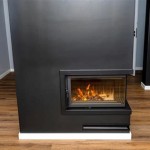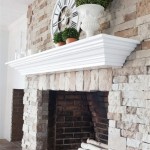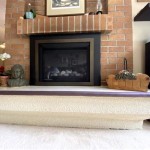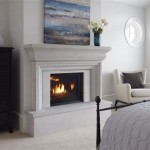Cleaning Ventless Gas Fireplace Logs: A Comprehensive Guide
Ventless gas fireplaces offer a convenient and aesthetically pleasing heating solution for many homes. The realistic appearance of the ceramic logs contributes significantly to the fireplace's ambiance. However, over time, these logs can accumulate soot, dust, and other debris, diminishing their visual appeal and potentially affecting the efficiency of the fireplace. Regular cleaning is, therefore, crucial for maintaining the fireplace's optimal performance and appearance.
Unlike traditional wood-burning fireplaces, ventless gas fireplaces do not have a chimney for smoke and combustion byproducts to escape. Instead, they rely on a carefully balanced combustion process to minimize the production of pollutants. Soot accumulation on the logs, however, can disrupt this balance, leading to incomplete combustion and the release of undesirable emissions into the home. Furthermore, a layer of soot can insulate the logs, potentially affecting their radiant heat output. Thus, proper cleaning not only enhances the fireplace's aesthetics but also ensures its safe and efficient operation. This article provides a detailed guide on cleaning ventless gas fireplace logs, covering the necessary preparations, step-by-step cleaning procedures, and essential safety precautions.
Preparing for the Cleaning Process
Before commencing the cleaning process, meticulous preparation is essential. The first step involves gathering the necessary tools and materials. These typically include:
- A soft-bristled brush (e.g., a paintbrush or toothbrush)
- A vacuum cleaner with a hose attachment
- Mild dish soap
- Warm water
- Several clean cloths or sponges
- Protective gloves
- Eye protection (goggles or safety glasses)
- A drop cloth or old newspaper
The next crucial step is ensuring the fireplace is completely cool. Attempting to clean the logs while they are hot can lead to severe burns. Allow ample time for the fireplace to cool down completely, typically several hours or overnight, after it has been turned off. Disconnecting the gas supply is also highly recommended as a safety precaution. Most ventless gas fireplaces have a shut-off valve located near the unit. Turn the valve to the "off" position to cut off the gas supply. Refer to the manufacturer's instructions for the specific location and operation of the gas shut-off valve for the particular fireplace model.
Protecting the surrounding area is also vital to prevent accidental damage or staining. Spread a drop cloth or old newspaper around the fireplace to catch any falling debris or cleaning solution. This precaution will save time and effort in cleaning up after the process. Finally, consulting the fireplace's owner's manual is highly recommended. The manual may contain specific cleaning instructions or warnings relevant to the particular model, ensuring that the cleaning process is performed safely and effectively.
Step-by-Step Cleaning Procedure
Once all preparations are complete, the actual cleaning process can begin. The following steps outline a detailed procedure for cleaning ventless gas fireplace logs:
- Log Removal: Carefully remove the ceramic logs from the fireplace. Note their original arrangement before removing them to ensure accurate reassembly later. Taking a photograph of the log placement can be helpful as a reference. Handle the logs with care, as they are often fragile and can break easily.
- Dry Brushing: Using the soft-bristled brush, gently remove loose dust and soot from the surface of each log. Avoid applying excessive pressure, as this could damage the ceramic material. Pay particular attention to crevices and textured areas where dust tends to accumulate.
- Vacuuming: Use the vacuum cleaner with the hose attachment to remove any remaining loose debris from the logs. The vacuum cleaner will help to remove the dust dislodged by the brush.
- Washing: Prepare a solution of mild dish soap and warm water. Dip a clean cloth or sponge into the soapy water and wring out the excess. Gently wipe down each log, removing any remaining soot or grime. Avoid soaking the logs in water, as excessive moisture can damage them.
- Rinsing: Using a clean, damp cloth or sponge, rinse each log with clean water to remove any soap residue. It is important to remove all traces of soap, as it can affect the fireplace's combustion process.
- Drying: Allow the logs to air dry completely before reassembling them in the fireplace. This may take several hours, or even overnight. Ensure that the logs are thoroughly dry to prevent any moisture-related issues.
- Reassembly: Once the logs are completely dry, carefully reassemble them in the fireplace according to their original arrangement. Refer to the photograph taken earlier, if needed. Ensure that the logs are positioned correctly to allow for proper gas flow and combustion.
After reassembling the logs, inspect the burner area of the fireplace. Use the vacuum cleaner to remove any accumulated dust or debris from the burner. A clean burner ensures proper gas flow and efficient combustion. Finally, reconnect the gas supply by turning the shut-off valve back to the "on" position. Before using the fireplace, test it to ensure that it is functioning correctly. Watch for any unusual odors, flames, or noises. If any issues are detected, consult a qualified fireplace technician.
Addressing Stubborn Soot and Stains
In some cases, the soot and stains on the fireplace logs may be particularly stubborn and difficult to remove with the standard cleaning procedure. Several alternative methods can be employed to address these challenging stains:
- Baking Soda Paste: Create a paste of baking soda and water. Apply the paste to the stained areas and allow it to sit for several minutes. Then, gently scrub the area with a soft-bristled brush or sponge. Rinse thoroughly with clean water. Baking soda is a mild abrasive that can help to lift stubborn stains without damaging the logs.
- Vinegar Solution: A solution of equal parts white vinegar and water can also be effective for removing stains. Apply the vinegar solution to the stained areas and allow it to sit for a few minutes. Then, gently wipe the area with a clean cloth or sponge. Rinse thoroughly with clean water. Vinegar is a natural cleaner that can help to dissolve grease and grime.
- Professional Fireplace Cleaner: Several commercially available fireplace cleaners are specifically designed for cleaning ceramic fireplace logs. Follow the manufacturer's instructions carefully when using these products. Ensure that the cleaner is safe for use on ceramic logs and that it will not damage the fireplace's components.
When using any of these alternative cleaning methods, it is crucial to test the solution on a small, inconspicuous area of the log first to ensure that it does not cause any discoloration or damage. Furthermore, always rinse the logs thoroughly with clean water after using any cleaning solution to remove any residue. If the stains persist despite these efforts, it may be necessary to consult a professional fireplace cleaning service. In extreme cases, the logs may need to be replaced. It is important to choose replacement logs that are specifically designed for the fireplace model to ensure proper fit and safe operation.
Regular cleaning of ventless gas fireplace logs is essential for maintaining their appearance, ensuring their safe operation, and maximizing their heat output. By following the steps outlined in this guide, homeowners can effectively clean their fireplace logs and enjoy the warmth and ambiance of their fireplace for years to come. Adhering to safety precautions and consulting the owner's manual are crucial for a successful and safe cleaning process. With proper care and maintenance, a ventless gas fireplace can provide a reliable and aesthetically pleasing heating solution for any home.

Why Is It Important To Get My Gas Fireplace Logs Clean Regularly

Ventless Gas Fireplace Maintenance Guide Fireplaces Direct Learning Center

Gas Log Maintenance Is Important Royal Oak Mi Fireside Hearth

Vent Free Gas Burner Maintenance

Empire Flint Hill Ventless Gas Log Set Woodland Direct

Vent Free Gas Log Sets A List Of Do S And Don Ts

Empire Rock Creek See Through Ventless Gas Log Set Woodland Direct

Duluth Forge 18 In 30000 Btu Dual Burner Vent Free Gas Fireplace Logs With Thermostat And Remote The Department At Com

Real Fyre Chas Charred Aged Split Ventless Gas Log Set Stainless Steel Ansi Certified

Duluth Forge 22 In W Vent Free Natural Gas Fireplace Log Set Winter Oak 32 000 Btu Thermostat Control Dls N22t The Home Depot
Related Posts








